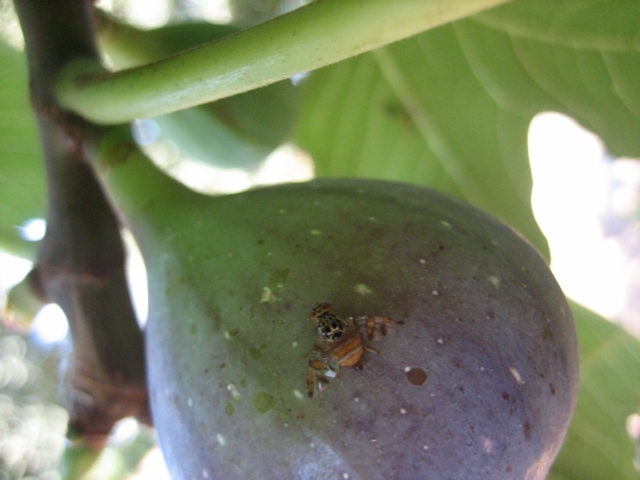
Fruit Fly
Ceratitis Capitata
Pathogen:
Insect
Type:
Risk:
HIGH



DESCRIPTION
Description of the pathogen
Ceratitis capitata, known as the fruit fly, is a pest of global agricultural importance. Adults are small, 3 to 5 mm in length, with a yellowish body and red eyes. Females lay eggs inside ripe fruits using an ovipositor. Each female can lay several hundred eggs in her lifetime. The eggs hatch into white larvae that feed on the fruit pulp, causing significant internal damage. After completing their larval development, the larvae emerge from the fruit and burrow into the soil to pupate. The pupal stage develops in the soil and then the adult emerges, completing the cycle. The complete cycle can last from 2 to 6 weeks, depending on environmental conditions, mainly temperature and the availability of suitable fruits.
Description of the disease
The disease caused by the fruit fly in figs or fig trees manifests itself mainly through physical damage and degradation of the fruits. The fly larvae feed on the pulp of the fruit, causing its decomposition and promoting the appearance of secondary infections due to fungi and bacteria. This not only reduces the quality of the fruit, but can also lead to total loss of production.
- Taches on the skin of the fruit where the females laid eggs.
- Softening and internal rot of the fruit.
- Presence of galleries and tunnels inside the fruit.
- Premature fall of infested fruits.
- Development of mold and bad odor due to secondary infections.

TEMPERATURE AND HUMIDITY
20-30 °C
60-80 %

TRANSMISSION ROUTES
Infested fruits, soil, wind, contaminated tools

Chemical treatments
CONTROL
• PARAFFIN OIL (CAS [64742-46-7]) 79% [EC] P/V
• Ceratitis capitata (Pheromone)
• DELTAMETHRIN 0.015% [RB] P/P
• DELTAMETHRIN 0.015g/trap [RB] P/P
• DELTAMETHRIN 0.03% (10 mg s.a./dispenser) [RB] P/P
• LAMBDA CYHALOTHRIN (0.0075 g s.a./trap) [RB] P/P
• HYDROLYZED PROTEINS 30% [SL] P/V
• HYDROLYZED PROTEINS 36% [SL] P/V
• HYDROLYZED PROTEINS 5.9% [AL] P/V
• TRAPS
• TRAPS FOR DIPTERANS
• FRUIT FLY TRAPS
Authorized treatments in organic farming
• PARAFFIN OIL (CAS [64742-46-7]) 79% [EC] P/V
• Ceratitis capitata (Pheromone)
• DELTAMETHRIN 0.015% [RB] P/P
• DELTAMETHRIN 0.015g/trap [RB] P/P
• LAMBDA CYHALOTHRIN (0.0075 g s.a./trap) [RB] P/P
• HYDROLYZED PROTEINS 30% [SL] P/V
• HYDROLYZED PROTEINS 36% [SL] P/V
• HYDROLYZED PROTEINS 5.9% [AL] P/V
• TRAPS
• TRAPS FOR DIPTERANS
• FRUIT FLY TRAPS
Biological control
• BEAUVERIA BASSIANA (STRAIN ATCC 74040) 2.3% (2.3X10E7 VIABLE SPORES/ML) [OD] P/V
Preventive treatments
• BEAUVERIA BASSIANA (STRAIN ATCC 74040) 2.3% (2.3X10E7 VIABLE SPORES/ML) [OD] P/V
• Ceratitis capitata (Pheromone)
• TRAPS
• TRAPS FOR DIPTERANS
• FRUIT FLY TRAPS
- Implement monitoring and mass capture traps to reduce the adult population.
- Use mosquito nets or nets to protect the fruits.
- Carry out regular inspections and eliminate infested fruits from the field.
- Apply specific insecticide treatments at key moments of pest development.
- Promote the use of biological control by introducing natural enemies of the fruit fly.
- Maintain good crop hygiene, eliminating plant debris and fallen fruits.
- Carry out cultural practices such as crop rotation to reduce pest pressure.
Recommendations
*The recommended treatments are recommendations based on the authorities' databases and in no way replace the guidelines established by the legislation of each country.





